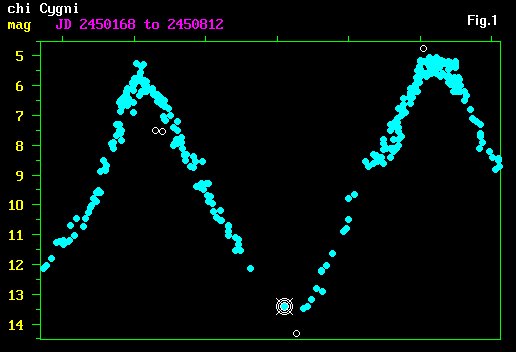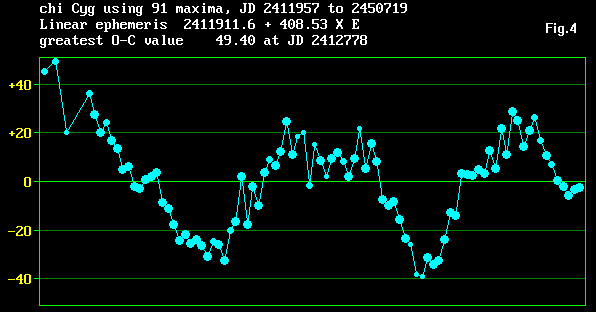
As noted in the BAA Journal1, chi Cygni was the first variable to exceed a 100 year record in the BAAVSS database. Now there are several more and although I am usually pre-occupied with the task of logging further observations old and new, it is difficult not to want to do at least some analysis on such a wealth of data. A program was written some time ago for compiling lists of mira maxima and minima directly from the archive and recently Karen Holland suggested short articles based on these lists could be considered for publication. Also, John Greaves has discussed in letters further statistical techniques which I might easily add. This encouragement has led me to check through the existing program and at the same time derive 91 maxima for chi Cygni. 86 minima were also derived in a similar way but only the maxima are discussed here.


 |
Maxima are determined by first loading two years of data into the program
and selecting a suitable 'window' with a double edged curser set initially
to 50 days width and then adjusted as necessary. Fig.1 shows the display of
1996 to 1997 before defining the window. Stray observations (shown as open
circles) can be omitted from the calculation by stepping the crossed
concentric-circle indicator along the observation set.
Least-squares quadratic equations2 are then applied to the selected set of observations and the JD at maximum of the fitted parabola (Fig.2) is filed along with the UT date, the days before and after maximum in the time window, the number of observations used and any excluded, the 'goodness of fit' and the magnitude. |

When the table of maxima is completed, a least-squares line is fitted to them (so called 'Linear Regression'3) thus deriving the elements from which a series of O-C values are generated. For this the program applies weights of 3, 2, and 1 for Good, Average, and Poor (or Estimated) maxima and Fig.4 indicates these with Large, medium, or small dots respectively. As can be seen, the O-C values range from -40 to +49 days with the latter occuring in the 1890's near the beginning of the dataset. Although the pre-1905 observations could not be checked and validated to the same extent as later results, the initial excursion of these early O-C away from the fitted (zero) line is probably real; we can see in other places that consecutive O-C (of Good fits) differ by up to plus or minus 20 days and conclude that times of maxima of chi Cyg really do wander by this amount. The rough sinusoidal shape of the O-C diagram indicates that a periodic term would tend to 'straighten it out', but I believe such terms are no longer thought to describe real cyclic phenomena in mira stars.
Predicted maxima from the derived elements; 2411911.6 + 408.53E
JD2451130 = 1998 Nov 12 (The 1998 BAA Handbook gives Nov 08)
JD2451538 = 1999 Dec 25
JD2451947 = 2001 Feb 06
JD2452356 = 2002 Mar 22
JD2452764 = 2003 May 04